theartsdesk in Tallinn: Music Week in the European City of Culture | reviews, news & interviews
theartsdesk in Tallinn: Music Week in the European City of Culture
theartsdesk in Tallinn: Music Week in the European City of Culture
The Estonian capital caters for all musical tastes from Chopin to death metal
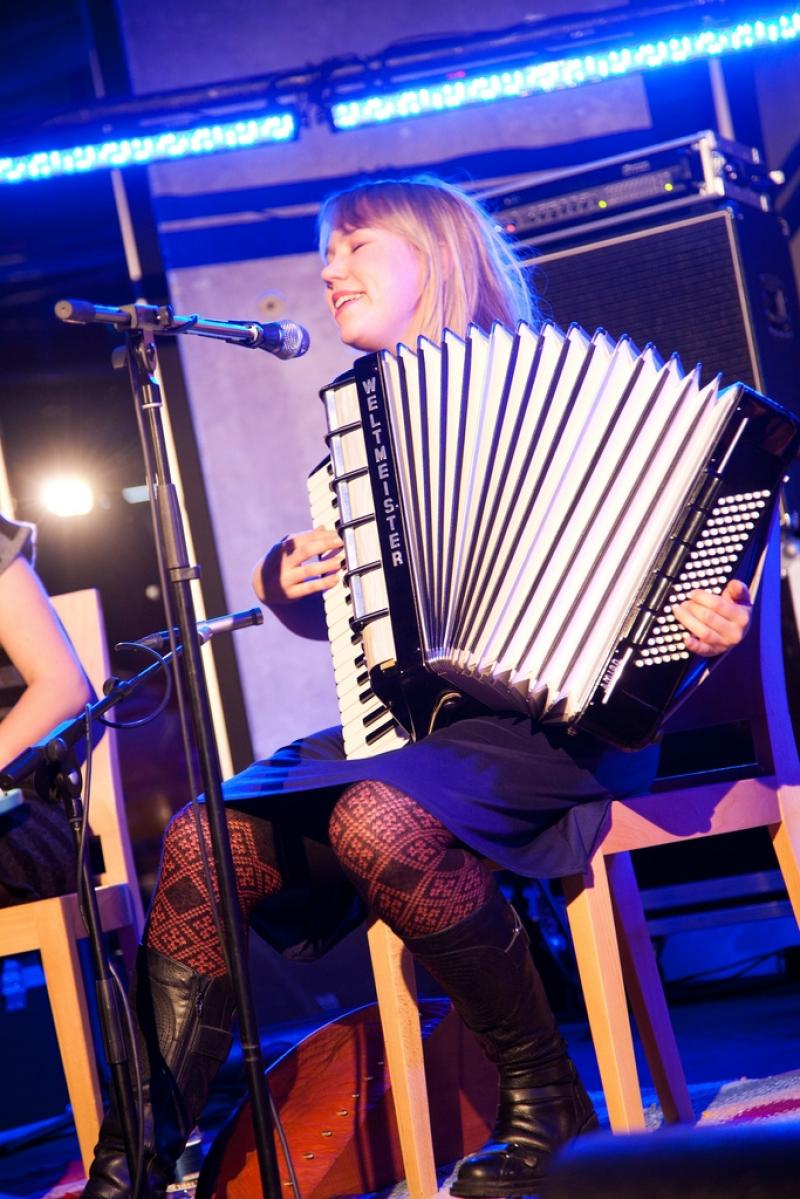
It’s an important year for Estonia. The Baltic nation celebrates 20 years of independence from Russia. Capital city Tallinn is European Capital of Culture for 2011. It’s also 10 years since their Eurovision win. theartsdesk is here for Tallinn Music Week, the third annual celebration of the country’s music. Integral to the national fabric, music was fundamental to the independence movement: the move to split from Russia was dubbed “The Singing Revolution”.
There’s no doubt that Estonia’s music – like the Estonian-developed Skype - resonates beyond its borders, even though Tanel Padar and Dave Benton’s Eurovision winner “Everybody” didn’t lead to the duo scaling the heights of our charts. Eurovision, the acclaimed Estonian Philharmonic Chamber Choir and the internationally known composer Arvo Pärt are pieces of a jigsaw. The importance of the music is recognised by President Toomas Hendrik Ilves, who turns up at shows and addresses the festival's opening press conference (pictured below, at the opening event). He's a big Arcade Fire fan.
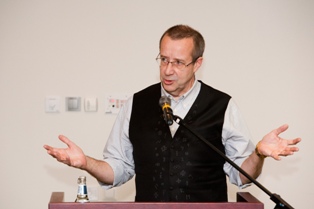 Pieces were revealed to me last October when two of the stand-outs at Finland’s Lost in Music festival were Estonian – the highly odd conceptual folk singer Orelipoiss and pop girl Iiiris. One of my favourites is the long-running (they formed pre-independence) band Röövel Ööbik, a spiky-edged New Order/electro-leaning rock band. Estonia is more Nordic inclined than Baltic (Finland is a two-hour ferry ride away), so of course there’s lots of heavy metal in here. These broad stylistic sweeps are reflected in Tallinn Music Week. Reinterpretations of traditional local folk are here. Rap and classical pianists too. And more.
Pieces were revealed to me last October when two of the stand-outs at Finland’s Lost in Music festival were Estonian – the highly odd conceptual folk singer Orelipoiss and pop girl Iiiris. One of my favourites is the long-running (they formed pre-independence) band Röövel Ööbik, a spiky-edged New Order/electro-leaning rock band. Estonia is more Nordic inclined than Baltic (Finland is a two-hour ferry ride away), so of course there’s lots of heavy metal in here. These broad stylistic sweeps are reflected in Tallinn Music Week. Reinterpretations of traditional local folk are here. Rap and classical pianists too. And more.
The city itself is a curious mix too. Old and new sit side by side, sometimes jarringly so. A former brewery that’s become a restaurant/bar/arts complex has a new blue-glass multistorey block sitting astride one of the brick buildings. It’d work fine on its own as a modern office block, but simply looks odd, as though the architect paid no attention to any disconnect between the old and the new.
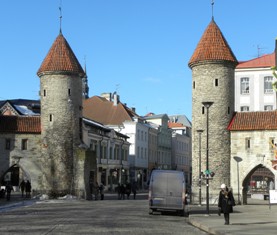 West of the city centre the old town (Vanalinn) - the pretty much perfectly preserved medieval area - is stuffed with extraordinary buildings dating from the 15th century onwards (pictured left, the eastern entrance to the Vanalinn). Streets radiate from the town hall square (raekoja plats). The area doesn’t feel northern European due to the Gothic architecture. A few houses could have been built for Dutch merchants in the 16th or 17th centuries – indeed, they could have as Tallinn’s medieval wealth derived from it being a Hanseatic trading city.
West of the city centre the old town (Vanalinn) - the pretty much perfectly preserved medieval area - is stuffed with extraordinary buildings dating from the 15th century onwards (pictured left, the eastern entrance to the Vanalinn). Streets radiate from the town hall square (raekoja plats). The area doesn’t feel northern European due to the Gothic architecture. A few houses could have been built for Dutch merchants in the 16th or 17th centuries – indeed, they could have as Tallinn’s medieval wealth derived from it being a Hanseatic trading city.
But the olde worlde atmosphere is tempered by bar after bar, tourist shop after tourist shop (amber and medieval-style knick-knacks on sale) and scads of theme restaurants – all aimed at visitors ranging from Finns hunting bargain booze, British stag parties and Russians on a budget holiday. It is a cheap city – even trendy bars don’t charge more than €2 for a beer.
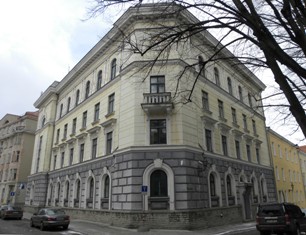 Expectations that there might be an obvious Russian hangover are dashed. A few women walking about sport head-to-foot fur but folks look generically (and fashionably) northern European. In the old town, the former KGB headquarters gives no indication of its former role (pictured right).
Expectations that there might be an obvious Russian hangover are dashed. A few women walking about sport head-to-foot fur but folks look generically (and fashionably) northern European. In the old town, the former KGB headquarters gives no indication of its former role (pictured right).
Modern Estonia – especially with its music – has no shyness about saying what it is. European Capital of Culture events run all year – many, pre-existing or new, relate to music. April sees the Tallinn 2011 Choir festival, while the long-running and well-regarded Jazzkaar festival takes place later in the month. There's even a series of events in August celebrating film director Tarkowsky, whose Stalker was largely filmed in Tallinn. With its population of 1.3 million (Tallinn is home to 400,000), it's as though everyone in the country is involved in culture.
And that's what it feels like at Tallinn Music Week. Around 150 shows take place at 14 venues. Inevitably there’re a few Finns, some neighbouring Latvians and Lithuanians, the odd Russian and even Canada’s Devon Sproule. But 90 per cent is local. Everyone in Estonia must either have a band, be a DJ or play violin. Music is synonymous with the national identity.
Of course, this doesn’t necessarily mean that the music itself is always rooted in local traditions. Although - by now - heavy metal is so much part of the Northern European fabric it probably is a local tradition. Estonia is the music-business hub for the Baltic, and much music feeds into Lithuania and Latvia from Finland via Estonia. The traffic is mutual, meaning outward-looking metal thrives in Estonia. Tallinn Music Week's raft of guttural dark, death and speed-metal types grunt about doom, decay and Hades. Few deviate from the template, but one stands out – Silverstique, whose raison d’être is Eighties hair metal. Their female singer has what appears to be Samantha Fox’s old hair plonked on her head.
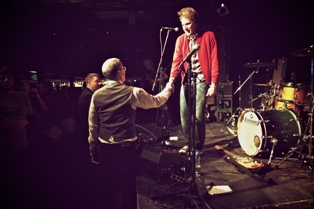 Indie types are less prevalent, but even so still draw from the familiar. Some are too in hock to their influences, instead of using them as a jumping-off point. Playing the old town's Von Krahl bar, Honey Power are – openly – Wedding Present influenced. The Fall and Pavement are in the scrubby guitar mix too. President Ilves liked them (pictured left, President Ilves with Honey Power, Tõnu Tunnel). The Emo/Radiohead direction of Aides was none too thrilling, however anthemic the choruses and furrowed-brow the delivery. Badass Yuki look as though they like Happy Mondays, but sound like The Beloved heard through a Madchester filter. Taken with France’s Shit Browne and Finland’s Shine 2009, they're more evidence that early-Nineties rave pop is edging back in.
Indie types are less prevalent, but even so still draw from the familiar. Some are too in hock to their influences, instead of using them as a jumping-off point. Playing the old town's Von Krahl bar, Honey Power are – openly – Wedding Present influenced. The Fall and Pavement are in the scrubby guitar mix too. President Ilves liked them (pictured left, President Ilves with Honey Power, Tõnu Tunnel). The Emo/Radiohead direction of Aides was none too thrilling, however anthemic the choruses and furrowed-brow the delivery. Badass Yuki look as though they like Happy Mondays, but sound like The Beloved heard through a Madchester filter. Taken with France’s Shit Browne and Finland’s Shine 2009, they're more evidence that early-Nineties rave pop is edging back in.
More satisfying are Ewert and the Two Dragons, a sunny and melodic pop quartet with songs that hint at Tahiti 80’s bossa nova moments. But the band that redraws Tallinn Music Week’s indie map are Väljasöit Rohelusse. Singing in Estonian and informed by “Just Like Honey” Jesus and Mary Chain they chuck in shoegazing and Gallon Drunk too. Their 10-minute final song, built around the descending "I Wanna Be Your Dog" riff, was splendid in its repetition. Asking the audience revealed that their name means – literally – “excursion to the green”. Colloquially, it would be "country holiday". Their relentless minimal chug didn’t conjure up images of bucolia.
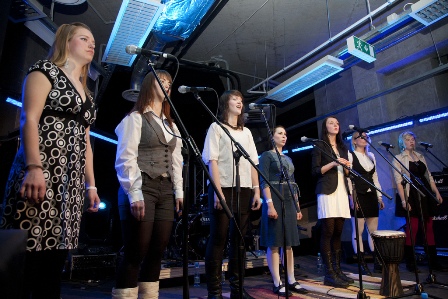 Music which drew on the landscape of Estonia – and was sung in Estonian – was clearly going to be folk-slanted. The seven-piece female a cappella outfit NolensVolens won Estonia’s Radio 2 new act of the year award. It’s easy to hear why (pictured right, Renee Altrov). Their assured set took in rounds that felt liturgical, even Gregorian. Occasionally bedding them with or interjecting vocal sound effects broke the spell. Not really folk, the singer-songwriter Mari Pokinen (who also sang with NolensVolens) played a solo set with an acoustic guitar that placed her as the Estonian Janis Ian with a smidge of Joni Mitchell. Hugely popular, her allusory songs were observations on Estonia and her relationship with it.
Music which drew on the landscape of Estonia – and was sung in Estonian – was clearly going to be folk-slanted. The seven-piece female a cappella outfit NolensVolens won Estonia’s Radio 2 new act of the year award. It’s easy to hear why (pictured right, Renee Altrov). Their assured set took in rounds that felt liturgical, even Gregorian. Occasionally bedding them with or interjecting vocal sound effects broke the spell. Not really folk, the singer-songwriter Mari Pokinen (who also sang with NolensVolens) played a solo set with an acoustic guitar that placed her as the Estonian Janis Ian with a smidge of Joni Mitchell. Hugely popular, her allusory songs were observations on Estonia and her relationship with it.
The biggest impact came from Mari Kalkun, who issued her second album late last year. Her sonic drift sits in the same world as Nico and Bridget St John. Melody was not the point, atmosphere was. Sat with a zither or an accordion, she explained her songs are about the wind, the elements. Also singing in rounds, the audience soon joined in – this was Estonia, the singing nation, coming alive. From the southern edge of Estonia, Kalkun’s lyrics are inspired by mid-20th-century poetry celebrating the landscape and people. The interplay with her violinist and Danny Thompson-ish stand-up bassist was semi-improvised and psychedelic, but never far from structure. A highlight.
Watch Mari Kalkun performing "Tii Ilo"
Another highlight was five-piece outfit Abraham’s Café. Beforehand, I’d pegged them as an ambient take on klezmer. This was something else. The front line was a clarinet and accordion. Nominally jazz, the clarinet let rip on some John Coltrane riffs that sat perfectly with the accordion. Striking and surprising, it nonetheless made sense.
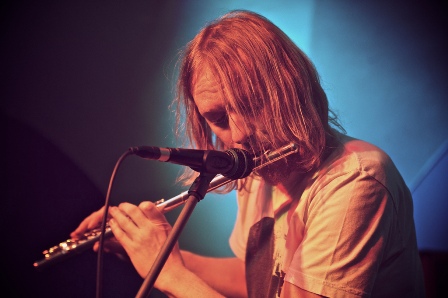 Equally off the wall was Pastacas, a gent looking like a cross between vintage Dave Brock and The Aphex Twin (pictured left, Tõnu Tunnel). In the fabulous vaulted medieval venue Mustpeade, moments bubbled up suggesting roots in rave and the A Twin, but the looping guitar was more Robert Fripp. Guitar sampled, he brought his flute out and began chanting. The music was melodic and rhythmic. Robert Fripp also wasn’t far from the drifting and ambient UMA, a duo with a sit-down guitarist (called Robert) who conjured "Morning Star" textures alongside his trumpet and hunting horn-playing companion.
Equally off the wall was Pastacas, a gent looking like a cross between vintage Dave Brock and The Aphex Twin (pictured left, Tõnu Tunnel). In the fabulous vaulted medieval venue Mustpeade, moments bubbled up suggesting roots in rave and the A Twin, but the looping guitar was more Robert Fripp. Guitar sampled, he brought his flute out and began chanting. The music was melodic and rhythmic. Robert Fripp also wasn’t far from the drifting and ambient UMA, a duo with a sit-down guitarist (called Robert) who conjured "Morning Star" textures alongside his trumpet and hunting horn-playing companion.
Watch Pastacas performing "Mi's"
Expectations were stretched even further by Tallinn Music Week's classical strand. The city’s Estonia Concert Hall was home to a three-hour series of showcases. Ten-minute set followed 10-minute set. Pianist Ralf Taal strolled on, but got to work instantly tossing off what sounded like treble-speed Chopin. More like watching a competition than a single concert, the classical showcases were rendered even odder by seeing them after midnight amongst an audience in suits and evening dresses. The rap and techno on elsewhere just didn’t have the same draw.
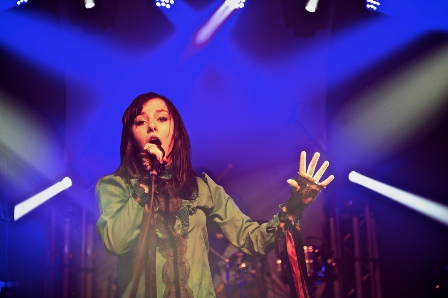 At the other end of the scale was woman-of-the-moment Iiris (picured right, Tõnu Tunnel). Her Von Krahl theatre show seemingly drew 4000 to a 600 or 800-capacity hall. Super-confident, she’s begun the conquest of her home turf as the foundation for her next steps.
At the other end of the scale was woman-of-the-moment Iiris (picured right, Tõnu Tunnel). Her Von Krahl theatre show seemingly drew 4000 to a 600 or 800-capacity hall. Super-confident, she’s begun the conquest of her home turf as the foundation for her next steps.
Tallinn Music Week is the most diverse of the city-centre music festivals I've seen. Lack of a unifying musical theme could lead to a lack of focus, but here it’s a strength. Everything has to be taken on its merits, regardless of genre or eccentricity of line-up.
It’s no stretch to imagine Pastacas winning over a festival audience anywhere. The clarinet/accordion interplay of Abraham’s Café initially seemed odd, but it was the music that counted and that was what hit home. Iiris is pure, quirky pop with songs at the heart. Setting the world of metal and ever-mobile globe-trotting DJs aside, it feels that the more unusual, more individual music from Estonia would attract international audiences. Mari Kalkun, who draws from her Estonian roots, reinforces this feeling - that music with a locally inspired vision affects most. With its wide-open door, Tallinn Music Week lets all Estonia’s music through.
Explore topics
Share this article
Add comment
The future of Arts Journalism
You can stop theartsdesk.com closing!
We urgently need financing to survive. Our fundraising drive has thus far raised £49,000 but we need to reach £100,000 or we will be forced to close. Please contribute here: https://gofund.me/c3f6033d
And if you can forward this information to anyone who might assist, we’d be grateful.

Subscribe to theartsdesk.com
Thank you for continuing to read our work on theartsdesk.com. For unlimited access to every article in its entirety, including our archive of more than 15,000 pieces, we're asking for £5 per month or £40 per year. We feel it's a very good deal, and hope you do too.
To take a subscription now simply click here.
And if you're looking for that extra gift for a friend or family member, why not treat them to a theartsdesk.com gift subscription?
more New music
 Heartbreak and soaring beauty on Chrissie Hynde & Pals' Duets Special
The great Pretender at her most romantic and on the form of her life
Heartbreak and soaring beauty on Chrissie Hynde & Pals' Duets Special
The great Pretender at her most romantic and on the form of her life
 The Last Dinner Party's 'From the Pyre' is as enjoyable as it is over-the-top
Musically sophisticated five-piece ramp up the excesses but remain contagiously pop
The Last Dinner Party's 'From the Pyre' is as enjoyable as it is over-the-top
Musically sophisticated five-piece ramp up the excesses but remain contagiously pop
 Moroccan Gnawa comes to Manhattan with 'Saha Gnawa'
Trance and tradition meet Afrofuturism in Manhattan
Moroccan Gnawa comes to Manhattan with 'Saha Gnawa'
Trance and tradition meet Afrofuturism in Manhattan
 Soulwax’s 'All Systems Are Lying' lays down some tasty yet gritty electro-pop
Belgian dancefloor veterans return to the fray with a dark, pop-orientated sound
Soulwax’s 'All Systems Are Lying' lays down some tasty yet gritty electro-pop
Belgian dancefloor veterans return to the fray with a dark, pop-orientated sound
 Music Reissues Weekly: Marc and the Mambas - Three Black Nights Of Little Black Bites
When Marc Almond took time out from Soft Cell
Music Reissues Weekly: Marc and the Mambas - Three Black Nights Of Little Black Bites
When Marc Almond took time out from Soft Cell
 Album: Mobb Deep - Infinite
A solid tribute to a legendary history
Album: Mobb Deep - Infinite
A solid tribute to a legendary history
 Album: Boz Scaggs - Detour
Smooth and soulful standards from an old pro
Album: Boz Scaggs - Detour
Smooth and soulful standards from an old pro
 Emily A. Sprague realises a Japanese dream on 'Cloud Time'
A set of live improvisations that drift in and out of real beauty
Emily A. Sprague realises a Japanese dream on 'Cloud Time'
A set of live improvisations that drift in and out of real beauty
 Trio Da Kali, Milton Court review - Mali masters make the ancient new
Three supreme musicians from Bamako in transcendent mood
Trio Da Kali, Milton Court review - Mali masters make the ancient new
Three supreme musicians from Bamako in transcendent mood
 Hollie Cook's 'Shy Girl' isn't heavyweight but has a summery reggae lilt
Tropical-tinted downtempo pop that's likeable if uneventful
Hollie Cook's 'Shy Girl' isn't heavyweight but has a summery reggae lilt
Tropical-tinted downtempo pop that's likeable if uneventful
 Pop Will Eat Itself's 'Delete Everything' is noisy but patchy
Despite unlovely production, the Eighties/Nineties unit retain rowdy ebullience
Pop Will Eat Itself's 'Delete Everything' is noisy but patchy
Despite unlovely production, the Eighties/Nineties unit retain rowdy ebullience

Comments
...
...
...
...